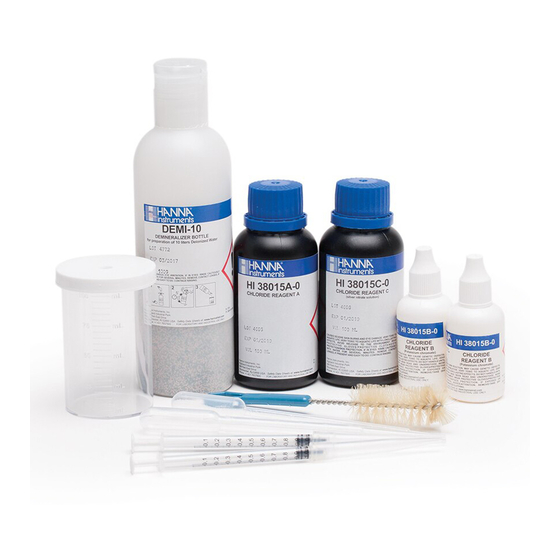
Advertisement
Quick Links
Instruction Manual
HI 38015
Chloride Extended
Range Test Kit
www.hannainst.com
SPECIFICATIONS
SPECIFICATIONS
SPECIFICATIONS
SPECIFICATIONS
SPECIFICATIONS
Dear Customer,
Thank you for choosing a Hanna Product.
Please read the instruction sheet carefully before using the
test kit. It will provide you with the necessary information
for correct use of the kit. If you need additional information,
do not hesitate to e-mail us at tech@hannainst.com.
Remove the test kit from the packing material and examine
it carefully to make sure that no damage has occurred
during shipping. If there is any noticeable damage, notify
your Dealer or the nearest Hanna office immediately.
Each kit is supplied with:
• HI 38015A-0 Chloride Reagent, 1 bottle (100 mL);
• HI 38015B-0 Chloride Reagent, 2 bottles with drop-
per (2x25 mL);
• HI 38015C-0 Chloride Reagent, 1 bottle (100 mL);
• Demineralizer Bottle with filter cap for about 12 liters
of deionized water (depending on the hardness level
of water to be treated) ;
• 1 calibrated plastic vessel (50 mL) with cap;
• 1 plastic pipette (3 mL);
• 1 plastic pipette (1 mL);
• 2 syringes (1 mL) with tips;
• 1 brush.
Note: Any damaged or defective item must be returned in
its original packing materials.
SPECIFICATIONS
SPECIFICATIONS
SPECIFICATIONS
SPECIFICATIONS
SPECIFICATIONS
Range
500 to 10000 mg/L (ppm) Cl
5000 to 100000 mg/L (ppm) Cl
Smallest Increment 100 mg/L [500 to 10000 mg/L range]
1000 mg/L [5000-100000 mg/L range]
Analysis Method
Silver nitrate titration
Sample Size
2.5 mL and 0.25 mL
Number of Tests
100
Case Dimensions
235x175x115 mm (9.2x6.9x4.5")
Shipping Weight
664 g (23.4 oz.)
SIGNIFICANCE AND USE
SIGNIFICANCE AND USE
SIGNIFICANCE AND USE
SIGNIFICANCE AND USE
SIGNIFICANCE AND USE
Chloride ions are one of the major inorganic anions in water
and wastewater. Although high concentrations of chloride in
water are not known to be toxic to humans, its regulation
is mainly due to adverse effect on taste. It is essential to
monitor chloride concentration in boiler systems to prevent
metal parts being damaged. In high levels, chloride can
corrode stainless steel and be toxic to plant life.
The Hanna Test Kit is equipped with all you need to
determine chloride level of water. The kit is quick and easy
to use.
Note: mg/L is equivalent to ppm (parts per million).
CHEMICAL REACTION
CHEMICAL REACTION
CHEMICAL REACTION
CHEMICAL REACTION
CHEMICAL REACTION
The chloride level in mg/L (ppm) is determined by a silver
nitrate titration, using potassium chromate as indicator.
The color change from yellow to brick-red determines the
end point of this titration.
INSTRUCTIONS
INSTRUCTIONS
INSTRUCTIONS
INSTRUCTIONS
INSTRUCTIONS
–
READ ALL THE INSTRUCTIONS BEFORE USING THE TEST KIT
–
Note: Label the two syringes to avoid cross-contamination
as follows:
tag the syringe to be used for sample extraction as
"S" and "T" the other for titration (HI 38015C-0).
High Range - 5000 to 100000 mg/L of Chloride
1- To measure chloride in the 5000 to
100000 mg/L range, rinse and fill
the S (sample) syringe with water
sample. Remove the cap from the
plastic vessel and add 0.25 mL of
sample.
Note: To measure exactly 0.25 mL of
sample with the syringe, push
the plunger completely into the
syringe and insert the tip into
sample. Pull the plunger out until
the lower edge of the seal is on
0.0 mL mark of the syringe. In-
sert the syringe into the vessel
and push the sample out until
the lower edge of the seal is on
the 0.25 mL mark (the longer
mark between 0.2 and 0.3).
2- Remove the cap and
fill the Demineralizer
Bottle with tap wa-
ter.
3- Replace the cap
and shake gently for
at least 2 minutes.
The demineralized
water is now ready.
4- Flip open the top of the Demineralizer Bottle cap. By
gently squeezing the bottle, add demineralized water
to the vessel up to the 25 mL mark. Replace the cap
and swirl to mix.
25 mL
5- Using the 1 mL plastic pipette, add to the vessel 1 mL
of HI 38015A-0 reagent. Replace the cap and swirl the
vessel in tight circles to mix.
6- While swirling the vessel, add
10 drops of HI 38015B-0 re-
x 10
agent through the cap port.
The solution will become a yel-
low color.
7- Take the titration syringe (T la-
beled), and push the plunger
completely into the syringe. In-
sert tip into HI 38015C-0 solution
and pull the plunger out until
the lower edge of the plunger
seal is on the 0 mL mark of the
syringe.
Caution: Avoid skin and eyes contact
with HI 38015C-0 reagent. It may
cause irritation to eyes and dark
spots on skin for some time.
8- Place the syringe into the cap of the
plastic vessel and slowly add the titra-
tion solution one drop at a time.
Swirling to mix after each drop. Con-
tinue adding titration solution until
the solution in the plastic vessel changes
from yellow to brick-red.
Advertisement

Summary of Contents for Hanna Instruments HI 38015
- Page 1 Instruction Manual SPECIFICATIONS SPECIFICATIONS SPECIFICATIONS SPECIFICATIONS SPECIFICATIONS INSTRUCTIONS INSTRUCTIONS INSTRUCTIONS INSTRUCTIONS INSTRUCTIONS – Range 500 to 10000 mg/L (ppm) Cl READ ALL THE INSTRUCTIONS BEFORE USING THE TEST KIT – 5000 to 100000 mg/L (ppm) Cl Note: Label the two syringes to avoid cross-contamination HI 38015 Smallest Increment 100 mg/L [500 to 10000 mg/L range] as follows:...
- Page 2 9- Read off the milliliters of titration solution from the syringe scale and multiply by 100000 to obtain mg/L (ppm) of Chloride. Low Range - 500 to 10000 mg/L of Chloride If the result is lower than 5000 mg/L, the precision of the test can be improved by following the steps below.











